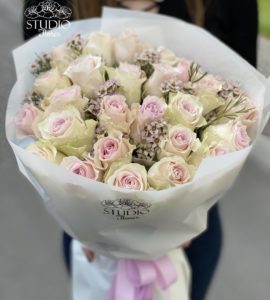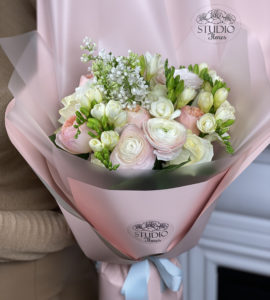You were invited to a wedding, and this means two things at once: first, you are among the people closest to future newlyweds, and the second, you will spend the next few days looking for the best wedding gift option and choosing the right bouquet for congratulating the newlyweds. To make it easier for the bride and groom’s friends and family to do this, we’ve explored and answered the most pressing wedding flower questions by putting together a quick guide on how to choose a bouquet for your wedding.
The selection of wedding compositions should be approached with great care: the wedding day is filled with symbolism and many signs, therefore, a careless or ill-considered bouquet choice can darken this important event. A few simple guidelines will help you avoid accidental oversights.
The bouquet should be in harmony with the general theme of the wedding. Each celebration has its own style and color. Inquire about these details before you start looking for a gift, and choose flowers according to the mood of the holiday.
Take care of the safety of the flower arrangement. The best bouquet for all types of weddings would be flowers in a basket or hat box: in addition to the fact that such a gift looks elegant and effective, the oasis soaked in moisture will keep the plants fresh regardless of environmental conditions.
Choose bouquets in advance and only in trusted stores. Delivery of wedding bouquets will help save time and effort before an important day, as well as relieve you of the need to take care of the freshness of flowers before they are delivered, however, you should rely only on those floristic studios in the quality of services of which you are one hundred percent sure of the quality of services.
The filling of a bouquet intended for newlyweds depends on who is the donor of the composition. The bride’s parents can congratulate their daughter with a touching bouquet of simple flowers (for example, spray roses, daisies, tulips), thus reminding them that she will always be a child for them.
The groom’s parents, on the other hand, congratulate the bride with a gorgeous composition of large Ecuadorian roses or Piano flowers. Grandmothers usually give granddaughters lush flowers: peonies, lisianthus, hydrangea. Friends invited to the wedding can safely experiment with bouquets, choosing one large exotic flower (for example, protea) or an armful of tropical orchids already familiar to our latitudes, compositions with ranunculus, irises, freesia and alstroemeria.
The choice of flowers for a wedding bouquet also depends on what time of the year the ceremony is held: for each season there is a list of “popular” plants, of which gift arrangements are usually made.
The classic all-season flowers that are most often included in wedding bouquets are roses: the varietal variety of these flowers allows you to compose congratulatory compositions from them regardless of the season.
The design of the bouquet directly depends on the theme of the wedding: for celebrations in the industrial or rustic style, it is recommended to refuse artificial decor, decorating the bouquet with live greens, berries or ears of corn. If the wedding theme is glamor or vintage, you can add pearls, glass beads, lace, organza, satin and silk ribbons and other decorative elements to the bouquets.
Beautiful bouquets for a wedding do not have to be lush and voluminous: florists offer sophisticated oblong bouquets (for example, from calla lilies), graceful messy compositions with an abundance of greenery, as well as delicate compliment bouquets. The number of flowers in the composition depends on the size of the buds: if the inflorescences or flower heads are small, they will look good in an amount of 11 to 25 pieces. Medium flowers are collected in a composition of 7-11 pieces, and if you have chosen plants with large buds, three to five flowers may be enough to create a wedding arrangement.
When choosing a wedding bouquet, florists recommend abandoning red and burgundy roses, as they symbolize passion, strong-smelling flowers (especially if the banquet is held in closed rooms) and typically “male” mono-bouquets – irises, calla lilies and gladioli. It is also undesirable to give chrysanthemums: these flowers are considered underlined formal, and the newlyweds can perceive a bouquet consisting only of chrysanthemums as “on duty”.


